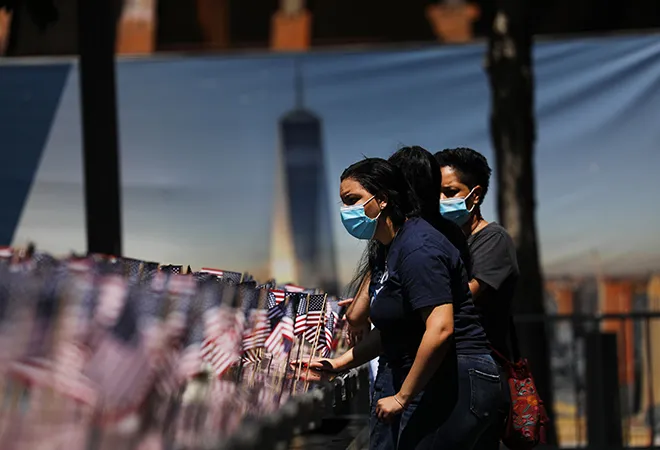
The US is dealing with a shifting threat landscape, which looks far different from the days of the so-called global war on terrorism. Since the 11 September 2001 al-Qaeda attacks through the rise of the Islamic State in Iraq and Syria (ISIS), the US has been primarily focused on combating the threat posed by Salafi-jihadist groups overseas, as well as working to prevent the radicalisation of American citizens who are encouraged to launch attacks on US soil.
In 2020, the threat has changed, and the US is now just as concerned about domestic terrorism as it is about transnational terrorism. To be sure, the transnational threats still remain, and even some of the far-right extremist groups born in the US have developed international connections. And as evidenced by the terrorist attack at Naval Air Station Pensacola by a Saudi Air Force lieutenant inspired by al-Qaeda in the Arabian Peninsula, Salafi jihadist groups like al-Qaeda and ISIS, and their affiliates, offshoots and franchise groups, will continue to search for innovative ways to attack the US.
Rising Domestic Terrorism
The US has been grappling with a sharp rise in domestic terrorism, specifically fueled by the broad category of far-right extremists, which includes violent white supremacists, neo-Nazis, anti-government militias and emerging movements like the so-called ‘Boogaloo Bois,’ motivated by a shared hatred of law enforcement<1>.
Violent white supremacists and neo-Nazis are the most clear and present danger. The Base is a neo-Nazi group that maintains linkages to Canada, Australia and South Africa, and promotes the idea of accelerationism, or destroying “the system” in a quest to eradicate governments and nation-states<2>. Its leader Rinaldo Nazzaro (aka Norman Spear) is allegedly based in St. Petersburg, Russia. Members of The Base, which in Arabic translates to ‘al-Qaeda,’ frequently display an affinity for jihadist groups and Osama bin Laden in their online propaganda<3>. Several members of The Base were arrested earlier this year as they planned to attack police officers and civilians involved in a pro Second Amendment (pro-gun) rally in Richmond, Virginia<4>.
The Atomwaffen Division (AWD) is another group with roots in the US that has now gone global. AWD has cultivated a relationship with the Azov Battalion. The group boasts transnational linkages with other groups too, including with Sonnenkrieg Division, a white supremacist group based in Europe, with strong membership in the UK and Eastern Europe. Its members also have linkages in Canada, Germany and Ukraine<5>. There have also been linkages to the Antipodean Resistance in Australia. The group has an intense obsession with violence, previously publishing videos featuring members training with firearms and spreading white supremacist propaganda<6>. Should the online network revolving around AWD ever metastasise into a full-scale underground terror movement, it could draw upon an anonymous globalised network with an indeterminate number of supporters.
Another domestic threat in the US are the so-called ‘Boogaloo Bois,’ part of a decentralised, nationwide network that is more of a loosely defined movement with a shared hatred of law enforcement than anything approaching a group or an organization<7>. The term “Boogaloo” itself is largely used online as a code word for civil war. Adherents of this movement foresee a conflict between armed citizens and law enforcement that ultimately results in the US government being violently overthrown. Members of the movement are highly visible at protests and demonstrations, often bedecked in trademark Hawaiian shirts<8>.
There exists a larger pool of far-right extremists beyond the Boogaloo, to include QAnon, white supremacists and other anti-government militia types. There remains significant potential for cross-pollination between these entities, and the 4chan /k/ board, where the feature is weapons, is one site where the co-mingling takes place<9>. The Boogaloo movement itself has become a repository for fringe extremists, many of whom hold conspiratorial beliefs and frequently reference false flag incidents, the Deep State, and disinformation related to the coronavirus<10>. Conspiracies have the potential to link the Boogaloo movement with the ever-growing and bizarre world of QAnon followers, who believe that well-connected elites like Hillary Clinton and George Soros are actually pedophiles that operate a global sex trafficking ring<11>. Several incidents have crossed over from the virtual world and have become violent, including the infamous ‘Pizzagate’ incident in Washington D.C. in 2016<12>. The movement has apparently spread to Canada, where it has gained new followers<13>.
A History of Extremism
Anti-government extremists and right-wing radical groups in the US have a long history. The militia and paramilitary movement in the US peaked in the 1990s when its broader membership was assessed at as high as five million members and sympathisers,<14> although terrorism expert Bruce Hoffman notes that realistically the number may have been closer to 100,000<15>. Still, following the election of Barack Obama, coupled with a devastating economic recession, the number of militia groups is estimated to have expanded significantly, from approximately 50 distinct groups to more than 276 over the next several years<16>. Hoffman divides the militias into “talking militias” (also known as “out-front” militias) and “marching militias,” (or “up-front” militias). The distinction is that the former is primarily concerned with the Second Amendment and issues related to anti-gun legislation, while the latter are “actively involved in violent, seditious activities, embracing the combination of revolutionary, racist, and anti-Semitic doctrines inherent in the wider American Christian Patriot movement”<17>.
A range of other conspiratorial beliefs permeate the broader Patriot and militia movement, most of which involve the idea that the US government will seek to subdue large numbers of Americans in detention camps, in some cases through a partnership between US special operations forces and foreign troops<18>. Because the militia and paramilitary movement is so diverse and the range of beliefs can vary from group to group, splintering is not uncommon as groups fall out with one another over issues including finances, political and religious beliefs, or disagreements over what should constitute ‘traditional values.’
Many of these militia groups adhere to a highly conspiratorial ideology that fears a shadowy cabal of elites and “a millenarian view of history”<19>. These groups are heavily armed and frequently glorify previous incidents where clashes occurred between federal agents and members of the movement, including seminal events such as the siege of compound in Ruby Ridge, Idaho, and the standoff at the Branch Davidian compound in Waco, Texas, in 1993<20>. Incidents like Ruby Ridge and Waco have had a radicalising influence on militia members, reinforcing their desire to remain on a “war footing” to defend against the belief that the US government is specifically targeting domestic militia and paramilitary groups<21>. Other incidents that are revered in the movement include Timothy McVeigh’s 1995 bombing of the Oklahoma City Federal Building. There have been numerous instances where militia groups have been arrested while attempting to acquire deadly toxins and contaminants to be used in terrorist attacks. Additional cases involve individuals arrested by the FBI for their interest in acquiring and using so-called “dirty bombs”<22>.
Sovereign citizens are distinct from the Patriot movement, but the Patriot movement employs some language, concepts, and conspiracy theories lifted from sovereign ideas. Sovereigns are less cohesive and organisational. Sovereign citizen ideas are strongly historically linked to white nationalism, but that element has receded, and there are quite large numbers of black sovereigns today, with closely related but somewhat different beliefs that lead to the same kind of behaviors. Tax resisters or tax protestors frequently attempt to conjure quasi-legal arguments to claim immunity from income tax, and often engage in tax fraud.
Uncertainty Ahead
Layered on top of the evolution is disinformation that has been introduced into white supremacy and far-right propaganda. COVID-19 has provided an opportunity for the far-right to push its worldview and ideology on its members and potential recruits. The usual scapegoats—Jewish people<23>, minorities<24>, and immigrants<25> —are blamed for the spread of the virus. The accelerationists within the far-right have also seized upon the unrest and instability surrounding the protests over the murder of George Floyd<26>.
With everyone at home during quarantine and spending time online, white supremacists and other anti-government extremists have had ample opportunity to recruit new members. Indeed, the first half of 2020 may well prove to be a watershed moment in recruitment and propaganda for domestic terrorist groups and other violent extremists in the US. In these troubling times, when even the US president is a frequent purveyor of disinformation and conspiracy theories, uncertainty abounds.
Unfortunately, the lead up to the November 2020 presidential elections will be a time of rising tensions in an already tense country. Foreign influence campaigns and disinformation will proliferate. And in a nightmare scenario, if US President Donald Trump were to lose re-election and go on to use social media to label it “rigged,” which he is already setting the groundwork for, the US could see some of the most sustained political violence, domestic terrorism and civil unrest since the late 1960s and early-to-mid 1970s, when protests over the Vietnam War destabilised the country.
Endnotes
<1> Seth Jones et al., “The Escalating Terrorism Problem in the United States,” Center for Strategic and International Studies, June 17, 2020.
<2> Daveed Gartenstein-Ross, Samuel Hodgson, and Colin P. Clarke, “The Growing Threat Posed by Accelerationism and Accelerationist Groups Worldwide,” Foreign Policy Research Institute, April 20, 2020.
<3> Max Rose and Ali Soufan, “We Once Fought Jihadists. Now We Battle White Supremacists,” New York Times, February 11, 2020.
<4> Shane Harris and Devlin Barrett, “FBI Arrests 3 Alleged Members of White Supremacists Group ‘The Base’ Ahead of Virginia Gun Rally,” Washington Post, January 16, 2020.
<5> Jacob Ware, “Siege: The Atomwaffen Division and Rising Far-Right Terrorism in the United States,” International Centre for Counter-Terrorism – The Hague, ICCT Policy Brief, July 2019.
<6> Ali Winston, “This Deadly Neo-Nazi Group’s Media Obsession Could Be Its Downfall,” The Daily Beast, March 1, 2020.
<7> Colin P. Clarke and Bruce Hoffman, “The Next American Terrorist,” The Cipher Brief, July 2, 2020.
<8> Jane Coaston, “The ‘Boogaloo’ ‘Movement,’ Explained,” Vox, June 8, 2020.
<9> Dale Beran, “The Boogaloo Tipping Point,” The Atlantic, July 4, 2020.
<10> Tess Owen, “Congress Just Got an Earful About the Threat of the Boogaloo Movement,” Vice News, July 16, 2020.
<11> Adrienne LaFrance, “The Prophecies of Q,” The Atlantic, June 2020.
<12> Cecilia Kang and Sheera Frenkel, “‘Pizzagate’ Conspiracy Theory Thrives Anew in the TikTok Era,” New York Times, July 14, 2020.
<13> Justin Ling, “QAnon’s Madness is Turning Canadians Into Potential Assassins,” Foreign Policy, July 13, 2020.
<14> Kathleen Belew, Bring the War Home: The White Power Movement and Paramilitary America, Cambridge: Harvard University Press, 2018, p.5.
<15> Bruce Hoffman, Inside Terrorism, 3rd ed., New York: Columbia University Press, 2017, p.109.
<16> Ibid
<17> Ibid, p.110.
<18> Sam Jackson, “Conspiracy Theories in the Patriot/Militia Movement,” George Washington University Program on Extremism, May 2017, pp.5-13.
<19> Michael Barkun, “Religion, Militias, and Oklahoma City: The Mind of Conspiratorialists,” Terrorism and Political Violence, Vol.8, No.1, Spring 1996, p.50.
<20> Michael Barkun, “Appropriated Martyrs: The Branch Davidians and the Radical Right,” Terrorism and Political Violence, 19: 117-124, 2007.
<21> J.M. Berger, “PATCON: The FBI’s Secret War Against the ‘Patriot’ Movement, and How Infiltration Tactics Relate to Radicalizing Influences,” New America Foundation, May 2012, p.3.
<22> Will Cathcart and Joseph Ari Epstein, “White Supremacists Want a Dirty Bomb,” Foreign Policy, August 16, 2019.
<23> Daniel Estrin, “New Report Notes Rise in Coronavirus-Linked Anti-Semitic Hate Speech,” NPR, April 21, 2020.
<24> Alex Napoliello, “How White Supremacists are Using the Coronavirus Pandemic to Spread Hate,” NJ.com, March 23, 2020.
<25> Anna Orso and Ellie Rushing, “White Supremacists and Other Extremist Groups are Using Protests and the Pandemic to Amplify Their Message,” Philadelphia Inquirer, June 13, 2020.
<26> Jamie Dettmer, “Who’s Behind Violence at George Floyd Protests in US,” Voice of America, June 4, 2020.
The views expressed above belong to the author(s). ORF research and analyses now available on Telegram! Click here to access our curated content — blogs, longforms and interviews.




 PREV
PREV


